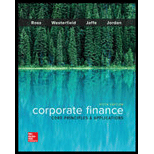
To discuss: The effect of increase in the length or period of investment on the future and present values
Introduction:
The
Explanation of Solution
Future value:
If the length of the period of investment increases, then the future value also increases. It is because the investment has a greater time to multiply. The following examples (1) and (2) justify this claim. The future value is higher when the investment period is 20 years, and the future value is lower when the investment period is 10 years.
Example 1:
The present
The formula to calculate the future value:
Where,
“FV” refers to the future value or the current market value
“PV” refers to the present value
“r” refers to the simple rate of interest
“t” refers to the number of years or periods of investment
Compute the future value:
Hence, the future value of investment after 10 years is $129.6871.
Example 2:
The present value of a bond is $50, and the rate of return is 10 percent. Determine the future value of the bond if the investment period is 20 years.
Compute the future value:
Hence, the future value of investment after 20 years is $336.3750.
Present value:
If the length of the period of investment increases, then the present value of the investment decreases. It is because a lesser present value of investment is sufficient to obtain higher future values if the investment period is longer, and higher present value of investment is necessary to obtain higher future values in a short period.
The following examples (3) and (4) justify this claim. The present value is lower ($74.3218) when the period of investment is 20 years, and the present value is higher ($192.7716) when the period of investment is 10 years. Hence, the present value of the investment decreases as the length of the investment increases.
The formula to calculate the present value:
Where,
“PV” refers to the present value of future cash flow
“FV” refers to the cash flow
“r” refers to the discount rate
“t” refers to the number of years or periods of investment
Example 3:
The future value of a bond is $500, and the discount rate is 10 percent. Determine the present value of the bond if the investment period is 10 years.
Compute the present value:
Hence, the present value of investment is $192.7716.
Example 4:
The future value of a bond is $500, and the discount rate is 10 percent. Determine the present value of the bond if the investment period is 20 years.
Compute the present value:
Hence, the present value of investment is $74.3218.
Want to see more full solutions like this?
Chapter 4 Solutions
Corporate Finance: Core Principles and Applications (Mcgraw-hill Education Series in Finance, Insurance, and Real Estate)
 Essentials Of InvestmentsFinanceISBN:9781260013924Author:Bodie, Zvi, Kane, Alex, MARCUS, Alan J.Publisher:Mcgraw-hill Education,
Essentials Of InvestmentsFinanceISBN:9781260013924Author:Bodie, Zvi, Kane, Alex, MARCUS, Alan J.Publisher:Mcgraw-hill Education,

 Foundations Of FinanceFinanceISBN:9780134897264Author:KEOWN, Arthur J., Martin, John D., PETTY, J. WilliamPublisher:Pearson,
Foundations Of FinanceFinanceISBN:9780134897264Author:KEOWN, Arthur J., Martin, John D., PETTY, J. WilliamPublisher:Pearson, Fundamentals of Financial Management (MindTap Cou...FinanceISBN:9781337395250Author:Eugene F. Brigham, Joel F. HoustonPublisher:Cengage Learning
Fundamentals of Financial Management (MindTap Cou...FinanceISBN:9781337395250Author:Eugene F. Brigham, Joel F. HoustonPublisher:Cengage Learning Corporate Finance (The Mcgraw-hill/Irwin Series i...FinanceISBN:9780077861759Author:Stephen A. Ross Franco Modigliani Professor of Financial Economics Professor, Randolph W Westerfield Robert R. Dockson Deans Chair in Bus. Admin., Jeffrey Jaffe, Bradford D Jordan ProfessorPublisher:McGraw-Hill Education
Corporate Finance (The Mcgraw-hill/Irwin Series i...FinanceISBN:9780077861759Author:Stephen A. Ross Franco Modigliani Professor of Financial Economics Professor, Randolph W Westerfield Robert R. Dockson Deans Chair in Bus. Admin., Jeffrey Jaffe, Bradford D Jordan ProfessorPublisher:McGraw-Hill Education





